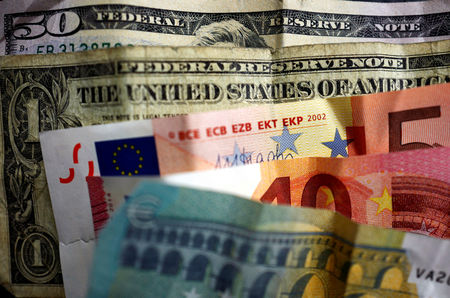
By Philip Blenkinsop
BRUSSELS (Reuters) – U.S. President Donald Trump has promised to address a longstanding trade deficit with the European Union, saying he will reverse that by imposing tariffs or making the EU buy more U.S. oil and gas.
In an “America First Trade Policy” memo issued on his first day back in the White House on Monday, Trump directed the Commerce and Treasury departments and the U.S. Trade Representative to investigate the trade deficit in goods and recommend appropriate measures by April.
European Commission President Ursula von der Leyen said on Tuesday the EU wants to engage and negotiate with the United States and warned of the risk of a “global race to the bottom” using tools such as trade tariffs.
Following are some key facts about the EU-U.S. trading relationship and how the two sides may interact in the coming weeks and months.
GOODS TRADE DEFICIT
Trump has tended to focus on goods trade alone and has frequently complained about the bloc’s car exports to the U.S. with few vehicles shipped east across the Atlantic.
Indeed, the EU has consistently exported more goods to the United States than it has imported and the U.S. goods trade deficit stood at 155.8 billion euros ($161.6 billion) in 2023, according to Eurostat data.
However, in services, the U.S. has a surplus of exports over imports with the European Union of 104 billion euros in 2023, according to Eurostat.
The United States is the EU’s largest trade and investment partner and each is the other’s largest source of foreign direct investment.
GERMANY DOMINATES EU EXPORTS
Germany is by far the EU’s largest exporter of goods, including of cars and machinery, to the United States, with more than 30% of all the bloc’s transatlantic goods exports in 2023. Italy, in second place, had a 13% share.
Many EU policymakers have called for EU unity in the face of the tariff threat. This proved a successful strategy in Brexit negotiations with admittedly smaller Britain.
However, EU unity on the issue is not guaranteed given the rise in recent years of more nationalist, populist politicians in several nations.
Officials in Brussels hope that right-wing Italian Prime Minister Georgia Meloni might provide a route into the Trump presidency. However, Hungarian Prime Minister Viktor Orban, who has a record of vetoing EU policy, notably over Ukraine, has said the Trump presidency could trigger a right-wing surge in Europe and more disruption of EU policy. In Austria, talks are underway to form a coalition government led by the eurosceptic far-right Freedom Party after it won an election last September.
OIL AND GAS
The United States has been the largest supplier of liquefied natural gas (LNG) to the European Union and Britain for the three years to 2023.
The U.S. provided 46% of EU LNG imports and 15% of oil imports in the third quarter of 2024, according to data from EU statistics office Eurostat.
Trump has said the bloc should import more U.S. oil and gas, but it is not clear how this is possible.
The United States is currently producing all it can produce and domestic consumption, already high, is rising in a number of sectors and due to the high energy needs of artificial intelligence. It does not have spare capacity to export.
Trump’s “drill, baby, drill” pledge could lead to sources from new projects, but they will take time to materialise. Perhaps he will demand that Europe signs longer-term contracts to buy more LNG.
Still, EU consumers of U.S. LNG are principally private companies, not governments, and their purchases are driven by price rather than politics.
The EU is still importing some LNG from Russia. A decision by the bloc to cut that off through sanctions could steer importers to look across the Atlantic.
For oil, the picture is similar.
MILITARY PURCHASES
Another factor in the trade equation is defence. Trump is pushing fellow NATO members to increase their defence spending and indeed, after Russia’s invasion of Ukraine, there is a general EU willingness to do so.
EU countries are still wrangling over the extent to which taxpayers’ money should be spent on non-EU arms and how far the bloc should boost its own defence industry.

European imports of arms from the United States have already grown, reaching 55% of all European arms imports in 2019-2023 from 35% in 2014-2018, according to the Stockholm International Peace Research Institute.
($1 = 0.9643 euros)
This post is originally published on INVESTING.


